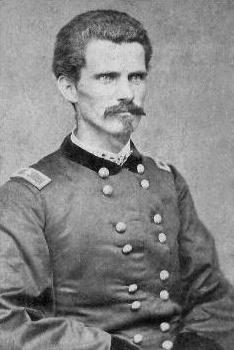Robert Francis Catterson facts for kids
Quick facts for kids
Robert Francis Catterson
|
|
|---|---|

Catterson in uniform, 1865
|
|
| 30th Mayor of Little Rock, Arkansas | |
| In office November 13, 1871 – November 10, 1873 |
|
| Preceded by | Jefferson G. Botsford (acting) |
| Succeeded by | Frederick Kramer |
| Personal details | |
| Born | March 22, 1835 Marion County, Indiana, U.S. |
| Died | March 30, 1914 (aged 79) San Antonio, Texas, U.S. |
| Cause of death | Stroke |
| Resting place | San Antonio National Cemetery 29°25′17.8″N 98°28′01.7″W / 29.421611°N 98.467139°W |
| Political party | Republican |
| Military service | |
| Allegiance | |
| Branch/service | United States Volunteers |
| Years of service | 1861-1866 |
| Rank | |
| Battles/wars | American Civil War |
Robert Francis Catterson (March 22, 1835 – March 30, 1914) was an important American figure. He was a doctor and a politician. He served as the 30th mayor of Little Rock, Arkansas from 1871 to 1873. During the American Civil War, he was a high-ranking officer in the Union Army. He also led a group of soldiers called a brigade in the Army of the Tennessee.
Contents
Early Life and Education
Robert Catterson was born on March 22, 1835. His birthplace was Marion County, Indiana. He went to college at Adrian College in Michigan. He also studied medicine at Cincinnati Medical College in Ohio. This school is now part of the University of Cincinnati Academic Health Center. After finishing his studies, Catterson started his own medical practice. He worked as a doctor in Rockville, Indiana.
Serving in the American Civil War
When the American Civil War began in 1861, Robert Catterson decided to join the Union side. He stopped working as a doctor to become a soldier. He joined the 14th Indiana Infantry. On April 23, he became a private in Company A. Then, on June 7, he was promoted to first sergeant. Catterson was later chosen to be an officer. He became a second lieutenant on July 5. The next year, on March 15, 1862, he was promoted to first lieutenant.
First Battles and Promotions
In 1862, Catterson fought in his first battle. This was during the Valley Campaign. He took part in the First Battle of Kernstown on March 23. On May 4, he was promoted to captain. Catterson then fought in the Maryland Campaign. He was at the Battle of Antietam on September 17. He was wounded during this battle. After he recovered, Catterson was promoted again. On October 18, he became a lieutenant colonel in the 97th Indiana Infantry. On November 25, he became its commander as a colonel.
Key Campaigns and Leadership
Catterson and his soldiers fought in the Battle of Memphis in Tennessee. This battle happened on June 6, 1862. They then helped occupy the city until late 1862. He also took part in the Siege of Vicksburg in the spring of 1863. That summer, he was part of the Tullahoma Campaign. Catterson and his command fought in the Third Battle of Chattanooga. This battle was from November 23 to 25. He also participated in the Atlanta Campaign throughout the summer of 1864.
March to the Sea and War's End
During Major-General William T. Sherman's famous Sherman's March to the Sea. This march happened in the winter of 1864. Catterson was part of the Army of the Tennessee. He led a brigade in its XV Corps. He started this role on November 22, 1864. He also fought in the Carolinas Campaign in 1865. He was at the Battle of Bentonville in North Carolina. This battle, from March 19 to 21, was one of the last major fights of the war. During the Carolinas Campaign, Catterson briefly served as a top assistant. He was chief of staff to Major-General John A. Logan. Logan was the commander of the XV Corps. Catterson then went back to lead his brigade. He led them for the rest of the campaign and until the war ended. On May 31, 1865, Catterson was given the honorary rank of brigadier-general. He left the volunteer army on January 15, 1866.
Life After the War
After the Civil War, Catterson did not go back to being a doctor. He moved to Arkansas. There, he tried a new business venture but it was not successful. He then became the commander of the Arkansas's militia. This was under Governor Powell Clayton. He worked to maintain order in the state. He also served as a U.S. Marshal. Later, Catterson lost favor with Governor Clayton. He was replaced as marshal by Isaac Mills. Catterson later led another militia group. This was during the Brooks–Baxter War in 1874.
Mayor of Little Rock
Robert Catterson served as the mayor of Little Rock, Arkansas. He was mayor from 1872 to 1874. After his time as mayor, he moved to Minnesota. There, he tried farming and selling farm equipment. These ventures were also not successful for him.
Later Years and Passing
Robert Catterson passed away at the age of 79. He died at the Veterans' Hospital in San Antonio, Texas. He had suffered from a stroke. Catterson was buried in the San Antonio National Cemetery. His grave is in Section A, Grave 176/177.

